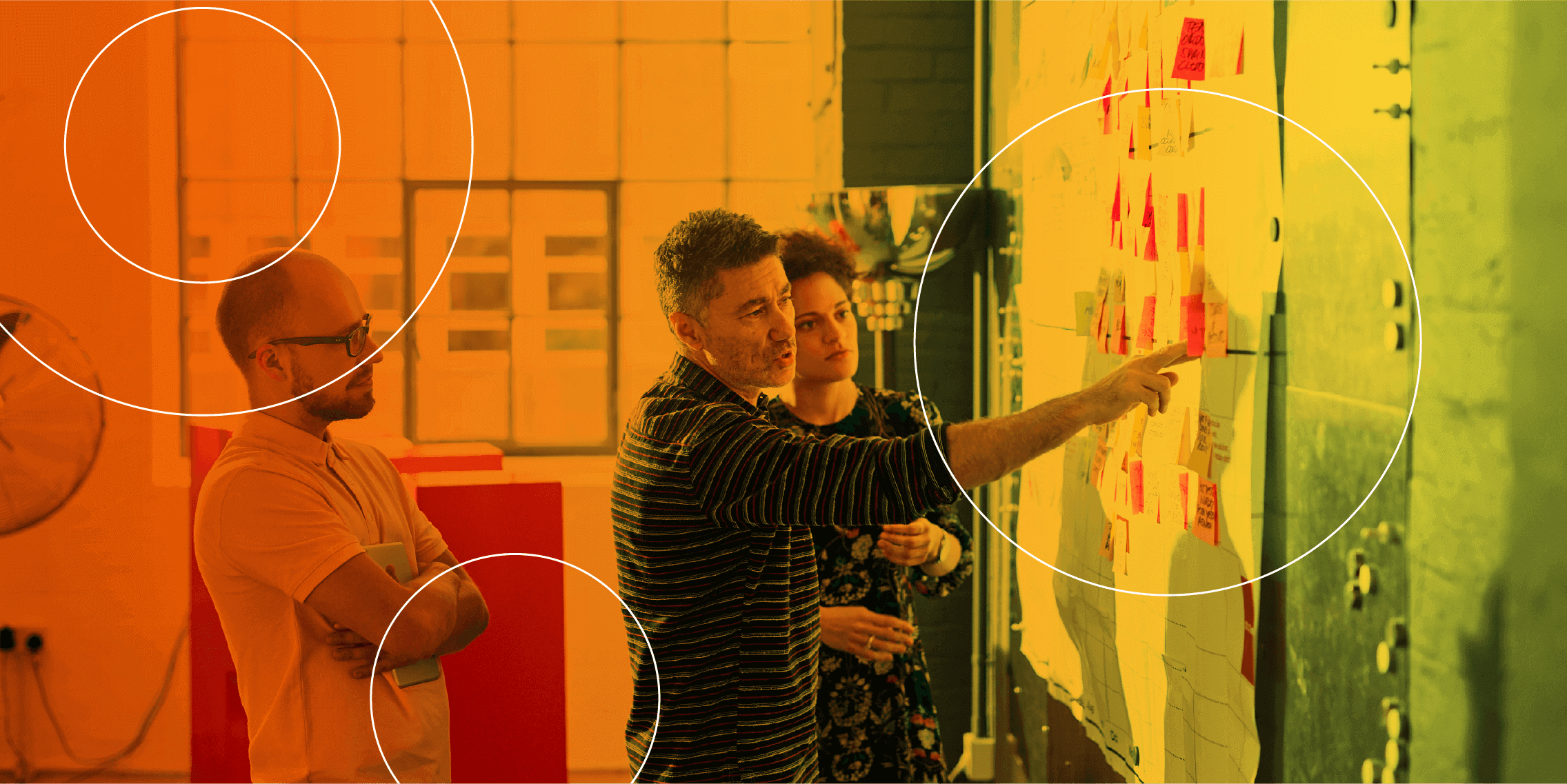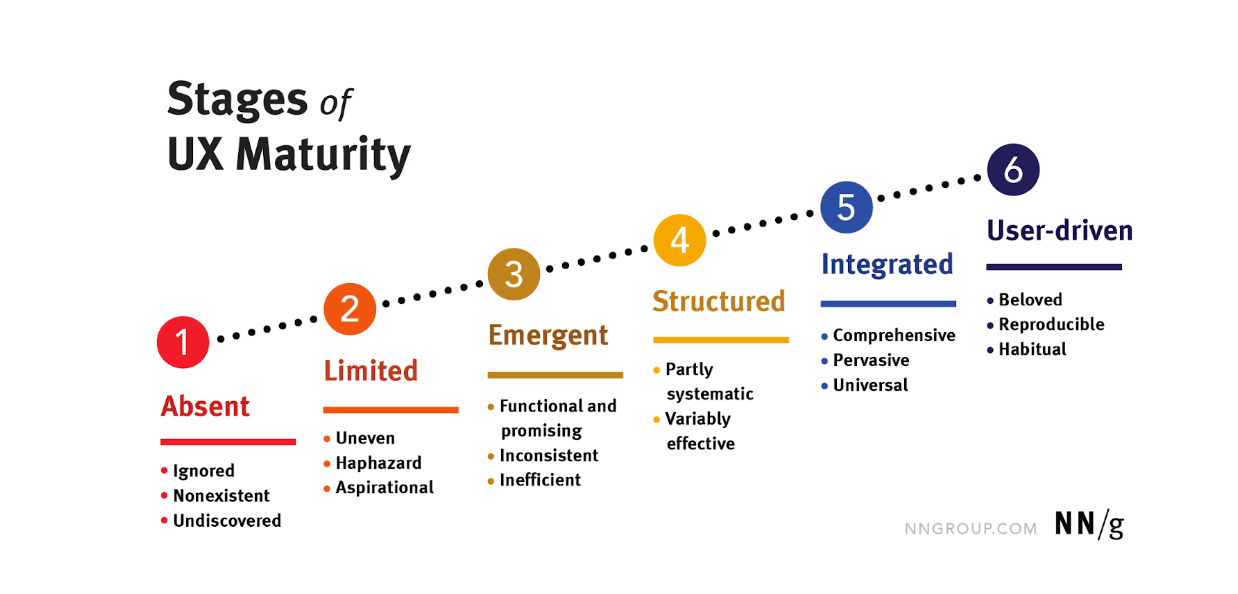If you’re a UX professional applying for jobs, you’ll want to make sure your next company cares about UX as much as you do. But how do you cut through all the noise to identify organisations that are truly invested in creating great digital experiences?
In this blog post, we’ll explain the concept of UX maturity—and equip you with a practical framework for measuring a company’s UX maturity level while job hunting.
- What is UX maturity?
- The six stages of UX maturity
- Why is UX maturity important when applying for jobs?
- How to evaluate a company’s UX maturity when job hunting
Let’s dive in!
1. What is UX maturity?
In today’s tech-driven landscape, it might seem like a given that most companies have at least a basic understanding of UX design—and why it’s so important. In reality, organisations across sectors have varying approaches to UX; ranging from seeing it as a ‘nice to have’ to making it the number one business priority. These varying approaches to UX are known as UX maturity levels.
The Nielsen Norman Group defines UX maturity as “the level of commitment an organisation shows towards user experience design.” In other words, how seriously a company takes UX—and the extent to which they’ve adopted user-centricity into their core values.
A higher UX maturity means UX practices, like UX research and user testing, are given enough time and resources to be implemented correctly. Companies with high levels of UX maturity tend to:
- Prioritise customer feedback
- Use data to drive decision-making, and
- Remain agile in their approach to product development
Which, overall, makes them better equipped to meet customer expectations.
On the other hand, lower levels of UX maturity mean the discipline isn’t taken seriously enough by senior leaders. As a result, UX activity is under-resourced and carried out sporadically—with little impact on the business.
2. The six stages of UX maturity
In 2006, Jacob Nielson of the industry-leading Nielsen Norman Group developed the UX maturity model, a practical framework detailing eight different stages of UX maturity within an organisation. The model was updated in 2021 and condensed into six stages; but well over a decade later, it’s still widely used as a benchmark for where companies should be in their approach to UX.
Let’s look at the six stages of UX maturity at a glance.
Stage 1: Absent
At this stage, UX is either ignored or nonexistent in an organisation—and senior leaders don’t think it’s a priority (or even something that’s needed). This means there are no formal employees focused on UX design, or any real advocacy for the user built into the product development process. This is usually the case in non-tech companies that have been around for a long time, with business models that don’t rely on individual users for revenue.
Stage 2: Limited
Companies with a limited approach to UX have an understanding of what it is, but still don’t see it as a priority. As a result, they’ll carry out UX-related activity on an occasional basis, without any real strategy. It may be seen as important by some members of the team, but it isn’t built into any formalised process. Without adequate time and resources, it lacks consistency and uniformity across products and services.
Stage 3: Emergent
Here, we start seeing a shift towards more intentional UX practices like wireframing and usability testing. Organisations at this level have started to realise the value of UX, and may have even hired some UX professionals in. But their efforts are still inconsistent and in need of structure and planning—which requires senior leaders to buy in to UX as a whole.
Stage 4: Structured
The structured stage sees organisations invest in UX on a more serious level. More UX professionals join to form a proper team, and there’s a recognition of the role UX plays in the overall business strategy in the senior leadership team. Standardised UX processes are being put in place throughout the product development process, but not everyone is on board with allocating resources towards it. This is where most companies sit in terms of UX maturity—and some never make it past this stage.
Read next: Balancing business needs and user needs in a product
Stage 5: Integrated
This is the stage when good UX becomes great UX. Widespread adoption of UX processes across all products and services means user satisfaction is becoming the norm. Everyone is on board with using UX methods to improve user outcomes, and usability sits as one of the business’ key success metrics.
Stage 6: User-driven
This final stage describes organisations whose dedication to user experience stretches beyond just having a dedicated UX department, but instead impacts every decision made at every level—from product planning to customer service. Everyone understands its importance, and strives towards creating exceptional outcomes through user-centred design practices (i.e., user interviews, user research, and usability tests).
[Source: Nielsen Norman Group]
3. Why is UX maturity important when applying for jobs?
When you’re looking for a job as a UX designer, it’s important to take UX maturity level into consideration. You might assume that a company hiring for a UX role in the first place is an indication of their maturity level. But before you sign any papers, it’s worth digging a little deeper.
Understanding an organisation’s UX maturity level will help you determine whether or not the team has enough knowledge and resources available to help you:
- Reach your personal development goals
- Get backing for your ideas
- Hit your professional targets
Companies with high levels of UX maturity typically have established systems that can easily integrate new designers into their workflow without disrupting existing processes. As a result, these companies tend to provide more support and guidance for their designers—which can steer them towards success more quickly.
On the other hand, low-maturity companies often struggle to attract high-quality UX talent because there are fewer growth opportunities. As a UX designer, the last thing you want is to arrive at a new company, armed with endless ideas on optimising the current UX processes—only to find you don’t have the resources or company buy-in to see them through. A job that leaves you frustrated could lead to you quitting prematurely.
4. How to evaluate a company’s UX maturity when you’re job-hunting
In the previous section, we explored why it’s key to understand a company’s UX maturity level before jumping aboard. But how do you go about measuring UX maturity as an outsider?
The answer is two-fold:
- Research, i.e., browsing the company’s website, LinkedIn, and any articles written about them in the press
- Asking the right questions in the interviews
So what exactly are you looking to find out?
- Existing processes the team has set up for product development. Do they have dedicated teams focused on research and usability testing, with well-defined roles for each stage?
- How much autonomy the UX designers currently have. Do they have free reign over decisions, or do they need approval from other stakeholders before making changes?
- Resourcing and budgets. What’s the quality of work coming out of the design team? Are there dedicated budgets allocated toward UX?
- Values and mission statement. How is UX woven into the company’s vision and mission?
- Case studies or customer reviews related to products developed by the team. What kind of feedback are people giving about their experiences using the products?
- Success metrics. Do they have an established baseline for evaluating user satisfaction, i.e., task completion rate?
Answering these questions can indicate where a company stands in terms of their commitment to UX, and allow you to make an informed decision about whether or not the job is right for you.
Round-up
Hopefully, this blog post helped you understand what to look out for (and what to steer clear of) when assessing UX maturity on your job hunt.
UX maturity isn’t a quick fix; it’s the lengthy process of developing a sophisticated and robust approach to UX—one that makes you competitive. More organisations are recognising that a high UX maturity level isn’t an advantage as much as it’s a universal expectation. Low UX maturity is a distinct disadvantage; one that sees organisations lose out on talent, customers, and traffic.
For more UX job hunt-related content, check out these blog posts:
- The ultimate guide to UX networking (and 5 tips for success)
- Why so many people are switching to careers in UX
- What hiring managers look for in a UX portfolio



![What does a UX designer do? [2025 Update] 3 what does a ux designer do blog header image](https://www.uxdesigninstitute.com/blog/wp-content/uploads/2020/09/10_What-does-a-UX-designer-do_Image.png)

